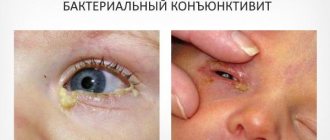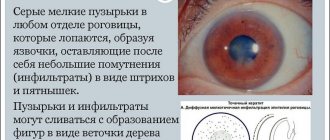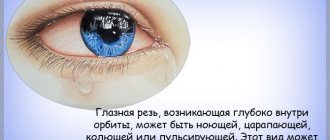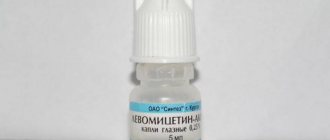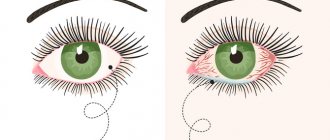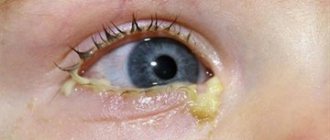Ophthalmology knows hundreds of eye diseases. The most common lesion of the human eye is purulent infection. The diseases have similar symptoms and complications, but present and are diagnosed differently. Also, eye diseases differ in treatment methods.
Purulent formations are most often a consequence of colds. Pathological ocular changes can cause infection. The appearance of pus can be caused by contact with dirty hands, towels and even bed linen. Traumatic effects on the organs of vision can cause purulent lesions.
In ophthalmology, there are several types of purulent eye infections: conjunctivitis, endophthalmitis, panophthalmitis, iridocyclitis. Ocular herpes, fungal keratitis, corneal ulceration, dacryocystitis, blepharitis and stye. These infections cause increased secretion of pus.
The mucous film, which protects the eye from external influences, is formed from the mucous membrane. If a person has a small amount of mucus after sleep, this is considered normal. It consists of mucin and meibomian gland cells. This is a fatty and slimy secretion, so the color of the mucus should be transparent or whitish.
If the discharge is infectious in nature, then the discharge is accompanied by redness and tearing. Burning and itching appears. The amount of mucus secreted increases significantly, the color becomes yellow-green, and the consistency thickens. When the first symptoms appear, you should immediately consult an ophthalmologist. It is necessary to establish the cause of the disease, its nature and an effective method of treatment.
The eye has a very important function in human life. Thanks to vision, a signal enters our brain, and we visually form a visualization of the world around us. Each eye performs its own function. Therefore, if even one eye is damaged, the picture changes.
The structure of the eye consists of the following parts: cornea, chamber of the eye, iris, pupil, lens. As well as the optic nerve, sclera, blood vessels, and retina. Each element is necessary to perform the basic functions of the eye.
Conjunctivitis
The disease develops as a result of inflammation of the mucous membrane of the eye. Inflammation of the conjunctiva can be caused by an infection or allergy. There are several types of this infection: allergic, bacterial, acute and chronic. In adults, conjunctivitis most often occurs, caused by an adenovirus. In children, adenoviral and bacterial are equally common.
The appearance of the disease can be caused by various infections. All kinds of gonococci, staphylococci, streptococci, Pseudomonas aeruginosa cause bacterial damage. The development of inflammation in the eye begins with a fungal process. There are a huge number of fungal groups of irritants, for example, aspergillus, actinomycetes, spirotrichel. Medicines, contact lenses, plants, dust can cause an allergic reaction. Sometimes, conjunctivitis can be considered an occupational disease when working conditions take place in a polluted environment and the eyes are exposed to dust and gas.
The general symptoms of the disease have a number of sensations that cannot be ignored. The eyelids begin to turn red, excessive lacrimation appears, pain in the eye, swelling, difficulty in visual function due to the appearance of purulent discharge.
At the first manifestations of conjunctivitis, you should seek medical help. Diagnosis of the disease is quick and not complicated. A visual examination and a series of tests will determine the cause of the infection. After consulting an ophthalmologist, the most effective treatment method is prescribed. Drug treatment includes a combination of eye drops and antibiotics. With proper and prompt treatment, complete recovery occurs within a few weeks.
Folk recipes
If a person has purulent discharge from the eye, then alternative medicine methods can be used to relieve symptoms and speed up recovery. They include the use of infusions and decoctions.
Rose hip
The fruits of the plant have pronounced anti-inflammatory properties. It is often used to make a solution that is recommended for washing the eyes. To prepare the medicine, the fruits are crushed to obtain 2 tsp. raw materials. Add 200 ml of water, after which the solution is placed on low heat and brought to a boil. After this, simmer the drug for 5 minutes and let it brew for half an hour. Rinse your eyes with the solution 5 times a day.
Dill
The juice of the plant successfully fights eye inflammation. To prepare the medicine, take 200 g of greens. It is washed in water and the juice is squeezed out. Then cotton pads are moistened in it and applied to the eyes. Keep the compress for 15 minutes. Repeat the procedure up to 6 times a day.
Potato
3 tubers are passed through a grater. Separate the white from the yolk of two eggs. After this, the ingredients are mixed and a homogeneous mass is formed. Cotton pads are moistened in the resulting drug and held to the eyes for 15 minutes. The procedure is repeated 5 times a day.
Kalanchoe
The juice of the plant is known for its antiallergic effect and eliminates tissue swelling. To prepare the drug, squeeze the juice from a freshly cut leaf. Moisten a cotton pad with it and apply it to the eyelids for 15 minutes. The procedure is carried out 4-5 times a day.
Traditional medicine recipes are effective as part of complex therapy. Under no circumstances should they be used as independent treatment. Before using alternative medicine methods, you should consult your doctor.
Endophthalmitis
A disease that occurs as a result of bacterial damage to the eye fluid. Infection with endophthalmitis occurs through blood circulation, injury to the eyeball, and surgery. The main cause of occurrence is postoperative complications to eliminate cataracts, vitrectomy, and glaucoma. The disease is asymptomatic, the patient seeks help when vision deterioration begins, and dark spots of various shapes appear in the eyes, which interfere with normal vision and eye movement.
Diagnosing endophthalmitis in the early stages is very difficult. Characteristic symptoms and previously performed eye surgeries become the only suspicion for the development of this pathology.
Treatment of the disease is immediate. Steroid drugs are administered enterally, antifungal agents and antibiotics are applied to the eye cavity. Approximately half of patients achieve a favorable prognosis for recovery. It depends on the cause of endophthalmitis, the age and health of the patient, and visual acuity. These factors influence the results obtained and the return of previous visual acuity.
conclusions
Discharge and sticking of eyelashes bring discomfort and significantly spoil the appearance. In addition, since the causes of suppuration are most often bacterial infections, there is a danger of the disease spreading to the skin (for example, red spots under the eyes) and other mucous membranes of the body. With proper and timely treatment, all these processes can be easily prevented and reduced. And thanks to prevention, visits to the ophthalmologist can become as rare as possible.
Also read about how to relieve spasm of accommodation, described in the article.
Panophthalmitis
The infection affects the sclera and all membranes of the eye, causing acute purulent inflammation. The cause is infection through the eyeball, as well as through the circulatory system. There is severe pain in the eye sockets. Swelling, fear of light, lacrimation, blurred vision. Chills and fever are common.
The inflammation is severe and acute. The disease has severe complications. Often leads to atrophy and death of the eyeball. The infection immediately spreads through the eyelids and lacrimal glands. The proliferation of microorganisms leads to inflammation, panophthalmitis is distributed over the entire surface of the eyeball.
The causative agents of this infection are staphylococci, pneumococci, tuberculosis bacteria, Pseudomonas and Escherichia coli. They enter the eye cavity exogenously or endogenously. Traumatic exposure is the most common type of injury; a purulent infection penetrates into the eyeball through a wound. Due to past diseases, such as keratitis, eyelid abscess, orbital phlegmon, endophthalmitis, the development of panophthalmitis may occur. The causative agents of the disease can be pneumonia, typhoid, sinusitis, sepsis, tuberculosis and many other diseases.
A few days after infection, panophthalmitis affects the eyeball. The disease develops rapidly and has acute symptoms. Headache, chills, vomiting. Severe leaks, cutting sharp eye pain, abundant accumulation of pus in the anterior chamber of the eye. Vision drops sharply, a person ceases to distinguish between light and dark, and complete blindness occurs. If the disease spreads and affects the internal tissues, the mobility of the apple becomes impossible. After a couple of months, pus is drained out through the holes in the sclera, the eye is squeezed out and atrophies. Pus can affect the meninges, causing meningitis and an abscess.
Panophthalmitis is diagnosed by an ophthalmologist during examination and assessment of existing injuries to the eyeball. Various types of ophthalmological examinations are prescribed. Timely diagnosis and treatment are the only way to recovery. Enhanced antibiotic therapy is prescribed immediately. Antifungal agents are prescribed. Baths and special intravenous drips made from salt solutions are used.
Drug treatment is often powerless. In such cases, removal of the cornea and the inside of the eyeball is urgently prescribed. Evisceration is used for loss of vision. An implant is sewn into the orbit and the cleaned area is sutured.
Ocular prosthetics is performed in the absence of an eyeball. An ocular prosthesis can consist of various materials. The prosthesis is first installed in a small size so that the patient gets used to wearing it. The size gradually increases. After wear occurs, the prosthesis should be replaced.
Herpes eye
The disease is caused by the simple herpes virus. Patients of any gender and age are at risk. Small purulent balls appear on the eyelids, which cut the eyelids and irritate the mucous membrane. Redness, tearing, and fear of light appear. More than 90% of the population suffers from the herpes virus. Herpes on the eye occurs due to inflammation of the trigeminal nerve. Symptoms are progressing.
Herpes is diagnosed only through laboratory tests. Eye ointments and immunomodulators are prescribed. Eye drops are used to limit damage to healthy tissue. Novocaine blockades will relieve pain and inflammation.
Iridocyclitis endogenous
Inflammation of the iris and ciliary body. Causes: arthritis, gout, psoriasis. Various infectious diseases caused by bacteria. For example, flu, measles, herpes, sinusitis, sinusitis.
When the eye is damaged, pain, lacrimation, photophobia, and decreased vision appear. The blood vessels in the eye dilate. The iris of the eye changes color. The pupils do not react well to light. Bloody and purulent accumulations appear at the bottom of the chamber.
The diagnosis is established based on the patient's complaints. The eyes are examined using a special microscope. The pupil may be narrowed and have an unnatural shape. Treatment is prescribed by an ophthalmologist. Antihistamines, corticosteroids and antibiotics may be indicated.
Diagnostic methods
The most important and basic method for diagnosing any disease of the organs of vision, accompanied by the discharge of pus, is an examination by an ophthalmologist. Typically, the doctor carefully examines the cornea, eyelids, conjunctiva and other tissues. Along with this, he can take a smear to determine the form of bacterial infection. Sometimes it may be necessary to review the patient's medical history to make a more accurate diagnosis. It is also important to collect information from his complaints.
Barley
A stye can be caused by a mite or a bacterial infection. The hair follicle becomes inflamed and pus begins to accumulate. Weakened immunity and bacterial infection, stress, skin diseases, anemia, eye contamination, and worms can cause stye.
There is redness and swelling of the affected eye. A pimple appears at the base of the lesion, from which yellow pus is released. Raising body temperature, chills, and swollen lymph nodes accompany the course of the disease.
During a medical examination, a test is carried out for the presence of skin mites, urine and blood tests are taken, and sugar levels are checked. Treatment of barley begins with treating the abscess with tinctures or alcohol. Antibacterial drops, tetracycline ointment, and vitamin therapy are prescribed to boost immunity.
Squeezing barley is strictly prohibited. The infection may spread to the entire eyelid. The use of prescribed medications by an ophthalmologist will lead to complete recovery in a week.
First aid
When the eyes are red and fester in an adult, this means the beginning of a disease process. It is very important to provide primary care to the patient in a timely manner, since the successful outcome of subsequent treatment depends on the speed of appropriate actions.
The eyes of an adult are festering - what to treat first?
- The very first action in case of suppuration of the organ of vision is to remove accumulations of pus. All therapeutic actions are carried out with clean hands. To remove pus, you need to rinse your eyes with moderately warm boiled water, then moisten a small piece of sterile cotton wool in a furatsilin solution, and thoroughly rinse the organ of vision from the outer to the inner corner.
- Before contacting an ophthalmologist, you can use anti-inflammatory compresses based on chamomile or calendula decoction or brewed black tea. Lotions and compresses help reduce inflammation of the eye. The compress is kept on the inflamed area for about 5 minutes.
Dacryocystitis
The inflammatory process begins in the lacrimal sac. Redness and swelling occurs in the area of the lacrimal opening. The pain may radiate to the nose and jaw. Purulent discharge comes out of the lacrimal sac.
Dacryocystitis can be congenital or acquired. The diagnosis is made by visual examination and analysis. Antibiotic therapy is selected. Use washing and probing of the lacrimal canals. Use CT or MRI to identify tumors and changes caused by dacryocystitis. To prescribe effective treatment, the cause of the disease must be determined. You need to get rid of it at the same time.
Treatment
After conducting an examination and establishing an accurate diagnosis, the ophthalmologist prescribes treatment. What it will be depends on the diagnosis.
For allergic conjunctivitis, it is necessary to accurately identify the allergen and exclude its interaction with the patient.
After this, antihistamines and rinsing with solutions of potassium permanganate, chamomile or calendula decoction are prescribed.
For viral conjunctivitis, special drops and ointments (Acyclovir, Interferon) and means to enhance immunity are used. To combat the pathogens of bacterial conjunctivitis, Moxifloxacin drops are prescribed.
Diseases caused by pathogenic fungi are a long and systematic process. To establish an accurate diagnosis and identify pathogens, laboratory tests are carried out on smears taken from the conjunctiva.
Patients treat the eyes with a manganese solution, instill chloramphenicol drops once an hour, and apply tetracycline ointment before going to bed. The doctor also prescribes antimycotic drugs.
Blepharitis is difficult to treat due to frequent relapses. The disease is provoked not only by various viruses and infections, but also by a weak immune system.
Therefore, in order to quickly achieve positive dynamics in the treatment of blepharitis, doctors prescribe a whole range of therapeutic measures.
Glucocorticosteroids and antibiotics will destroy pathogenic pathogens. Local medications will relieve the acute inflammatory process. Vitamin complexes will strengthen the immune system.
Dacryocystitis in the first stages is treated with conservative methods. Massage and rinsing of the lacrimal sac and nasolacrimal ducts using Dexamethasone (an anti-inflammatory drug) and Levomycitin, Ciprofloxan (antibacterial agents).
The addition of vasoconstrictor medications allows you to quickly stop the development of inflammation. If treatment is started on time, these funds are sufficient.
In advanced forms of dacryocystitis, surgical intervention is recommended:
- bougienage is carried out using a medical bougie and involves restoring the patency of the nasolacrimal duct;
- dacryocystorhinostomy - creation of a new canal between the lacrimal sac and the nasal cavity using rhinoplasty;
- Sometimes surgery is also required to open the stye. The procedure is performed on an outpatient basis, and the patient immediately goes home.
Blepharitis
A disease of the eyelids and their edges is called blepharitis. The eyelids change their shape due to swelling, redness is observed, and patients blink frequently. The cause can be various diseases, for example, gastritis, sinusitis, colitis. Allergies, lack of vitamins, infections are also the cause of the development of the pathological process. This disease is most often chronic. It is difficult to treat.
The majority of diseases appear due to bacterial infection. Personal hygiene rules should be observed. Always keep your face and hands clean. The use and dosage of any medications can only be prescribed by an ophthalmologist, based on the examination and research.
Many factors lead to loss of vision and the eyeball itself. In this case, ocular prosthetics are used. The shape of the prosthesis imitates the human eye. It does not convey visual function, but maintains the organs of vision in their anatomical position and improves the aesthetic appearance. This is a narrow area in ophthalmology, which every clinic cannot afford.
Prevention
Most eye diseases are transmitted by contact, so to avoid possible infection you must follow these rules:
- avoid contact with people who have an eye infection;
- do not touch your eyes with dirty hands;
- use only your own personal hygiene items;
- do not use other people's cosmetics, including ointments and creams;
- avoid severe hypothermia;
- Follow the rules for using contact lenses.


